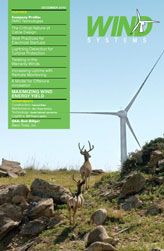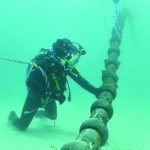Security of a wind project is a task that typically goes hand in hand with maintaining the assets and assuring high availability for the project owner. Unfortunately, some aspects of project performance can be cut short by the intentional efforts of others, specifically thieves and vandals. They can directly impact the success of a project during and after construction and will effectively diminish the potential profitability of a project, as repairs and replacements must be made.
Theft and Vandalism
While vandalism is probably the biggest security concern for wind turbine owners, copper theft has become a strong second. Copper prices have started to return to their previous decade-high levels of 2008, and with this increased value offer a higher incentive for would-be thieves wishing to gain access and remove power cabling from remote and unattended wind turbines. As one of the most important industrial metals, even recyclable or recycled copper prices have increased, giving rise to new state and federal laws to combat copper theft from businesses across the country. The costs of theft and vandalism on a project are difficult to predict as they are often random events, but projects that fall victim to such losses can face significant downtime and expense. Nearly one third of the cost to make repairs after a copper cable theft is related to the replacement cost of the stolen cable itself.
Even if you have never experienced a theft or act of vandalism, no project is necessarily immune to this type of loss. Projects complacent in their security efforts are often the ones targeted by criminals, and sometimes these events can shut the project down. Federal laws already provide ample language to deter trespassing and attempted damage to energy facilities, including wind projects. In the interest of national security, the U.S. Patriot Act of 2001 amended Title 18, United States Code Section 1366, to include attempted destruction of an energy facility. Since that time it became a federal offense, including severe fines and imprisonment, to damage or attempt to damage the property of an energy facility in the U.S. The amount of damage can be as little as $5,000, or if an attempted offense could have caused a significant interruption or impairment of an energy facility. Laws such as these give state law enforcement additional support to local trespassing laws, such as California’s Penal Code Section 602 (k) where even unenclosed or unfenced areas are covered if there is intent to destroy any property within the boundary. Most states also now have laws that establish distinctions for copper and metal thefts as either misdemeanors or felonies, and lay out minimum and maximum fines and penalties. As of August, 2010, legislation to reduce copper theft has been introduced in every state and passed into law in all but five.
Probably the best way to help control wind project theft and vandalism is to develop a thorough and sensible security plan before the start of construction, and to pass the procedures on to the post-construction O&M team. Use of proper lighting, alarm systems, fencing, and deployment of security patrol services are as important during construction as they are during commercial operations. The act of consistent and routine inventory of field spares should be made the responsibility of an assigned employee, ensuring that high-value materials are properly recorded when brought on site and also when they are used.
Proactive Planning
In high-theft areas, patrols and other forms of proactive security may be necessary. Due to the remoteness of wind projects, passive systems can be employed in most instances. For an unattended project application of door “trip switches” or perimeter alarms can be tied into the systems’ SCADA network, allowing remote centers to call local law enforcement or security teams. Since thieves will be less inclined to attempt a theft if they cannot readily enter and exit the site, mechanical security locking devices such as McGard bolts can help. Also, local law enforcement should be encouraged to patrol the area at night, and local residents can act as another form of security. With a proactive plan and diligent observation it is possible to keep a small nuisance from becoming a major problem.


































